
Amazon retail arbitrage can be profitable in 2024 if you:
Amazon retail arbitrage sellers sell products from major brands that are accessible to anyone at the store or through online retailers. Profit margins when reselling these products on Amazon are often slim. You need to compete for sales against other retail arbitrage sellers and Amazon wholesale sellers who can get these branded products at a discount because they purchase in bulk. An Amazon retail arbitrage seller on Reddit says that they differentiate their offer from other sellers by creating multipacks and product bundles of branded products. This allows them to create their own product listings and run ads to generate sales.


You can also look for products that are selling at a discount in limited locations instead of countrywide. That way, other retail arbitrage sellers can't drive down the price on Amazon before you can sell it.
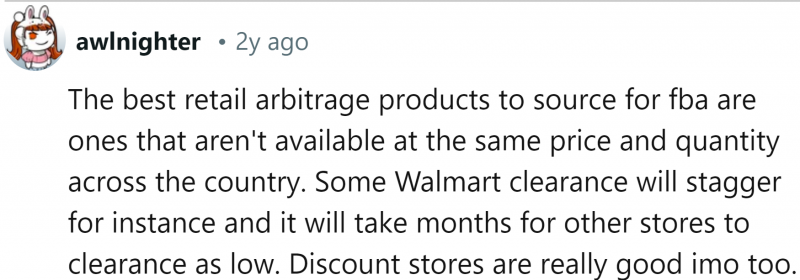
Retail arbitrage sellers using the Amazon FBA program for inventory storage and fulfillment should look for items in high demand that can sell quickly. This is because Amazon charges monthly storage fees. Amazon retail arbitrage profit margins are already razor thin in many cases, so accruing excessive Amazon FBA storage fees can turn a profitable item into an unprofitable item if it sits at the Amazon fulfillment center for too long.
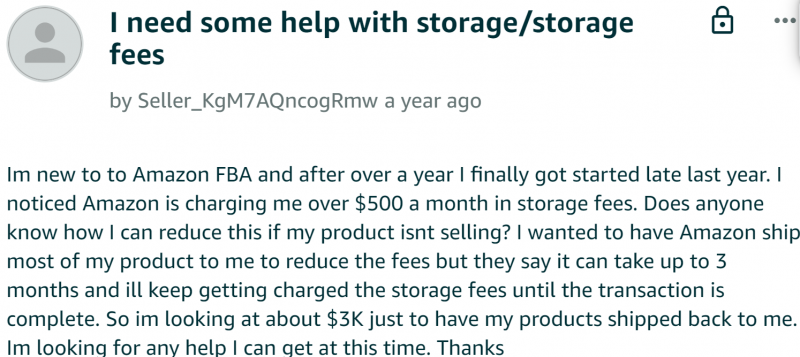
Before purchasing a product to resell on Amazon, retail arbitrage sellers should verify that they can sell the product because many branded products on Amazon require approval. Fortunately, if you’re already using the Amazon Seller App to scan products at the store to check profit potential, the app will also tell you whether your account is eligible to sell the product. However, some Amazon sellers report that retail arbitrage is only a temporary solution to generate Ecommerce profits because Amazon sellers are supposed to have B2B sales receipts for the items they sell. Amazon can request these receipts if they receive customer complaints and can suspend a seller's account if they cannot provide proof of purchase from an authorized distributor or manufacturer.

Amazon sellers can experience high return rates because Amazon offers its customers a favorable return policy. Although the Amazon FBA program pays for the return shipping from the customer back to the Amazon fulfillment center, Amazon does not reimburse sellers for the original FBA fulfillment fee to send the product to the customer. Amazon may also charge a returns processing fee to receive and restock the item in the Amazon warehouse. As such, a retail arbitrage product with a slim profit margin could become unprofitable if the product is returned.

Amazon retail arbitrage seller Nikki Kirk provides her audience with many tips for doing Amazon retail arbitrage profitably. When sourcing products from Costco, Nikki discloses that she prefers selling kids clothing and clothing in packages rather than adult clothing because these items have lower return rates.
An alternative online business model that has much higher profit potential than Amazon retail arbitrage is local lead generation. Local lead generation entails creating websites that attract customers for local service businesses. Although these websites cost a few hundred dollars to set up, they can generate $500 to $3,000/month, allowing site owners to enjoy profit margins of up to 90%.
In the following article, we discuss Amazon retail arbitrage profitability further by looking at factors like starting costs and income potential.
5 Unnoticed Pitfalls in Amazon Retail Arbitrage
1. Lack of product control
Retail arbitrage on Amazon product sourcing means depending on retail stores for inventory, but control is close to impossible. You must find another store if a retail store runs out of stock, discontinued a product, raises prices, or stops giving discounts. This lack of control is a major downside to this business model.
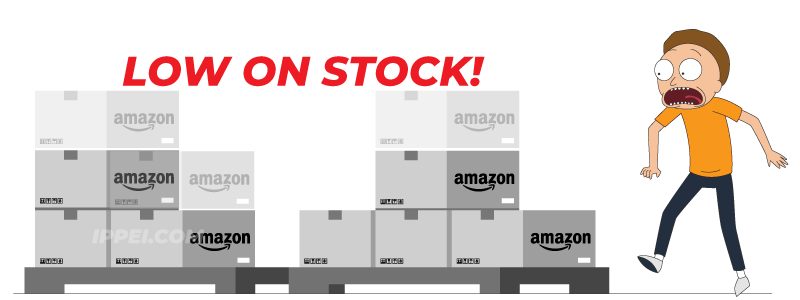
You're also entirely reliant on other retailers for your product supply, and if they won't sell to you, you have no inventory to sell. That means no income. Another big issue here is quality control. Damaged or defective retail arbitrage products may not be returned or replaced by retailers if not purchased from an approved distributor.
2. Lack of control over pricing and margins
Amazon retail arbitrage limits pricing and profit control. In this business model, you are not selling your own product and must compete with many other sellers. This leads to limited pricing and profit control. You pay for products from retail stores and face additional costs like Amazon fees, making the venture more competitive and challenging.
You also have no control on margins, it is tight as costs are set by retailer clearance sale and revenue depends on Amazon's selling price. This results in smaller profit margins, especially after considering Amazon's 15% commission and shipping costs.
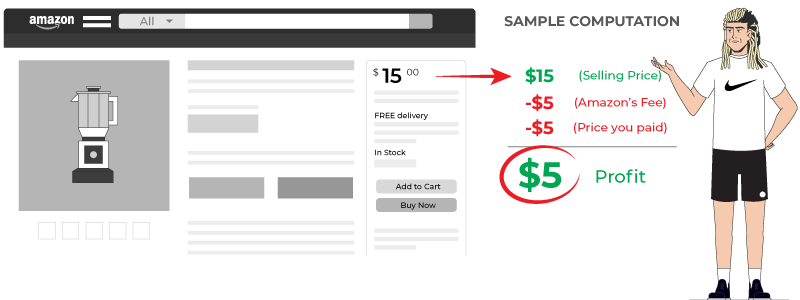
Let's do some math:
To calculate your profit, you need to know this formula:
Selling price - Amazon fees - Your cost = Profit
$15 (selling price) - $5 (Amazon's fees) - $5 (the price you paid to buy it) = $5 profit
This works best for items selling in the $15-$20 range and higher. But if an item is selling for $5 FBA, unfortunately, there's likely no way to make money on it. The reality is even if you can buy it for just $1 in the store. So take note always on that.
To learn more about Amazon retail arbitrage, read our article discussing if Amazon retail arbitrage is worth it.
3. Lack of scalability
Retail arbitrage is not scalable because:
4. Amazon can ban sellers

Don't risk being banned by selling products from retail stores through retail arbitrage. Stay informed to protect your selling privileges on Amazon. Brands like Nike can block amazon resellers from selling their products, leaving them stuck with unsellable inventory. To avoid such scenarios, research and follow Amazon's guidelines, including their gated categories, which may require proof of purchase from allowed distributors.
5. Lack of repeat business

Retail arbitrage on Amazon involves selling random products online for profit, leading to a constant change in products and difficulty in building customer loyalty. Especially if you’re selling basic products on Amazon, you won’t get any information about your customers, which makes it hard to create a loyal customer base. Even if you have the plan to attract customers, it is still difficult to keep customers coming back.
3 Major Perks of Amazon Retail Arbitrage
The three major perks of Amazon retail arbitrage that lead beginners to start their Amazon business with this business model because of its low entry requirements, no marketing needed, and the potential for fast profits.
1. Low entry requirements

Easy to start retail arbitrage on Amazon by buying clearance items at Walmart or Target and reselling them on Amazon, requiring only an Amazon seller account and consideration of shipping fees.
2. No marketing needed
Amazon retail arbitrage sellers rely on the brand power of the product's manufacturer to attract buyers, making it easier to sell in-demand, high-brand products.
3. Fast profits
Correct product selection can lead to quick profits, as inventory moves quickly even after accounting for shipping costs. Amazon FBA is a popular fulfillment option.

Amazon retail arbitrage is a business model that involves buying discounted products from retail stores and reselling them for a profit on Amazon.
For example, purchasing a clearance item at a discount store for $5 and reselling it on Amazon for $15. You basically have $10 profit before the Amazon fees.
What is Amazon Retail Arbitrage?

Retail arbitrage on Amazon is the practice of buying products from a retail store, such as Walmart or Target, and then reselling them on Amazon for a higher price to make a profit.
For example, a seller might purchase a clearance item at Walmart for $5 and then list it on Amazon for $15, earning a profit of $10 per item. The seller takes advantage of price discrepancies between brick-and-mortar stores and online marketplaces to make a profit.
How Much Does it Cost to Start Amazon Retail Arbitrage?
You can start retail arbitrage on Amazon for less than $500, and about 32% did so for less than $1,000 according to Jungle Scouts' study of over 1,000 Amazon sellers, of which 12% of those are retail arbitrage sellers. You are buying discounted products in small quantities, and the amount of upfront investment is extremely low.
How Much Can You Make with Amazon Retail Arbitrage?
You can make less than $5,000 per month with Amazon retail arbitrage according to 62% of retail arbitrage sellers and only 25% of them earn less than $500. Also, 46% of retail arbitrage sellers take up to six months to turn a profit, and 48% of profit margins on products are less than 20%. Successful Amazon resellers usually use Amazon FBA for inventory management and fulfillment services.
However, Amazon FBA comes at a cost. First off, Amazon takes a 15% cut off your sales right off the top. And if you choose to use Amazon FBA, the FBA fees will usually amount to another 15-20%. Which you need to always consider as an FBA seller. In the end, Amazon takes approximately a third of your revenue.
Online Arbitrage vs. Retail Arbitrage
Online arbitrage involves buying products from online retailers and reselling them on e-commerce platforms, while retail arbitrage involves buying products from physical stores and reselling them online. Online arbitrage offers convenience and automation, while retail arbitrage allows for finding unique and hard-to-find products.
How Does the Profitability of Retail Arbitrage Compare with other Amazon Business Models?
Jungle Scout’s survey of nearly 5,000 Amazon sellers reveals the profitability of other Amazon business models.
Business Model
Over half (56%) of private label sellers on Amazon make $5,000 or more in monthly sales, and over a third (35%) of them realize a profit within their first six months of selling.
Online Arbitrage
55% of online arbitrage sellers earn less than $5,000 per month on Amazon, 16% of them earn between $1,000 and $5,000. Additionally, 54% of online arbitrage sellers achieve profit margins of 16% or higher.
Wholesale
Over 61% of wholesalers on Amazon earn over $5,000 per month, while the majority (58%) of them have profit margins less than 20%.
About 4 in 10 (39%) dropshippers on Amazon earn $5,000 or less, with almost half (48%) of them achieving profit margins between 11-25%.
Handmade products
Despite this, handmade sellers have better margins on average, with over half (52%) achieving profit margins between 11-25%.
6 Outstanding Tips from Amazon Retail Arbitrage Expert

Ryan Grant
Amazon seller, Blogger, Coach and Speaker at Online Selling Experiment
Ryan Grant is an online entrepreneur and successful online seller who started his journey with just $1,000 worth of cameras and grew his business to sell over $2 million worth of products each year through retail arbitrage and other strategies. He is an expert in selling on Amazon, eBay, Walmart, and Home Depot. He is passionate about sharing his insights and strategies to help others succeed in online selling.
Ryan made $5.9M in 2018 through his Amazon business, and this excludes the additional revenue that he gets from his eBooks, courses, and the coaching sessions he offers. Retail arbitrage and online arbitrage contribute to half of their revenue in 2018.
To be successful in this venture, here are some things to keep in mind from Ryan Grant:
1. Download an Amazon scanner app
It will help you determine the profitability of an item. This app can provide valuable data, such as price, sales rank, competition, product history, and restrictions.
You can check my article about 7 best amazon retail arbitrage scanner apps.
2. Learn individual store markdown schedules
Gain an advantage over your competition. For example, Target follows a predictable markdown schedule on their clearance items. Some stores will discount items further the longer items sit on clearance. Figure out how each store runs and use this information to your advantage. Run through the list of top stores for retail arbitrage sourcing and know their schedules.
3. Be patient and take the time to learn the process
As you gain experience, you will become more efficient when you follow these top retail arbitrage sourcing tips. Selling retail arbitrage products on Amazon will not get you rich quickly.
4. Improve your product listing on Amazon
Increase your product's discoverability. Use relevant and complete information, and choose the right keywords for your product's title and description.
5. Choose popular categories on Amazon for increased profitability
Always check the trend. Popular categories for Amazon retail arbitrage include Home & Kitchen, Toys & Games, Beauty & Personal Care, Health, Household, Baby, and Kitchen & Dining.
If you want to learn more, you can check my article about the best Amazon retail arbitrage items.
6. Take as much time as you need at each store
Exert your time to search through all the clearance sections in one store before going to another store. This will help you find hidden gems, save some of your time and learn more about the store for future visits.
Why Beginners Fail With Amazon Retail Arbitrage?
1. Insufficient market research
Without proper research, you might end up buying products that are not profitable or have a low demand on Amazon. This can cause lower sales, lower profit margins, or even loss.
2. Poor sourcing
The success of retail arbitrage relies heavily on finding products at a lower cost than their selling price on Amazon. Failing to find good deals on products, or buying products that are not profitable, can cause a loss.
3. Inaccurate pricing
Pricing your products too high can cause lower sales or no sales at all, while pricing too low can reduce your profit margins. Finding the right balance can be challenging and requires careful research and analysis.
4. Lack of capital
Retail arbitrage requires a significant amount of capital to start with. Without enough capital, you may not purchase the right products in bulk, resulting in higher sourcing costs and lower profit margins.
5. High competition
Amazon retail arbitrage is becoming increasingly popular, so the competition is getting tougher. Finding profitable products can become more challenging with more competitors in the market.
6. Poor listing optimization
Listing optimization plays a crucial role in attracting potential customers to your products. Without proper optimization, your products may not rank high on Amazon's search results, resulting in lower visibility and fewer sales.
7. Violating Amazon policies
Amazon has strict policies regarding the selling of certain products, and failing to comply with them can lead to suspension or even permanent termination of your account. Therefore, it is crucial to be aware of Amazon's policies and regulations and follow them carefully.
Conclusion: Is Amazon Retail Arbitrage Profitable?
Yes, Amazon retail arbitrage can be profitable and worth it. It can offer some quick profits and provide insights into the Amazon marketplace. It may not be a long-term, profitable, and excellent investment. Its growth potential is limited, especially if you're not dedicating significant time and resources to it.
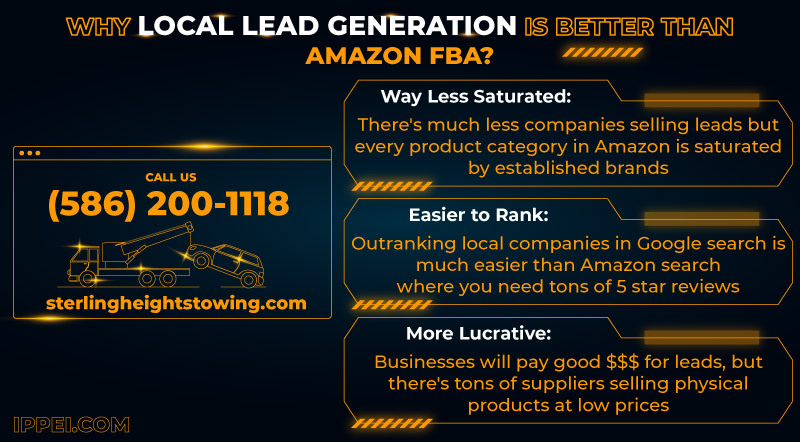
If you're looking for a scalable and sustainable business model, consider local lead generation. Local lead generation not only eliminates these unnoticed issues, but it is also a reliable source of passive income that provides stability and sustainability.
Unlike Amazon retail arbitrage, it involves creating a niche-specific website and allowing local companies to promote their services there. By relying on SEO tactics to generate organic traffic, it doesn’t depend on customer reviews to gain traction. Local lead generation also requires less maintenance than Amazon retail arbitrage. All you have to do is to keep your site ranked under Google’s algorithm.




